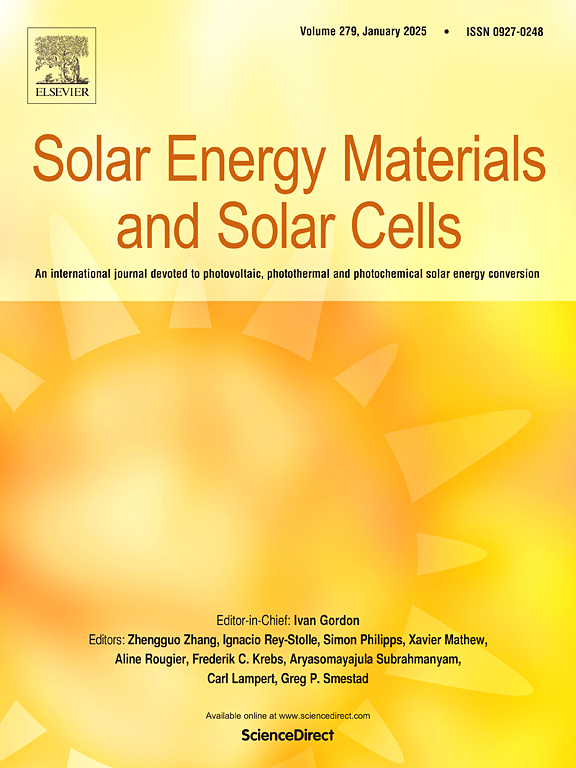IF 6.3
2区 材料科学
Q2 ENERGY & FUELS
引用次数: 0
摘要
基于相变材料(PCMs)的潜热热能储存(LHTES)系统的热效率仍然是其在太阳能和工业过程中广泛应用的一大障碍。在 PCM 中加入三重周期性最小表面(TPMS)晶格的 LHTES 系统表现出卓越的储热性能。然而,模型高度这一关键结构参数对 LHTES 系统蓄热行为的影响尚未得到定量分析,从而阻碍了进一步优化。本研究使用简化的中心柱模型来评估两种 TPMS 结构(I-WP 和 Primitive)在三种高度(15、30 和 45 毫米)下的蓄热行为,并将它们与传统的金属泡沫(BCC)进行比较。结果表明,随着模型高度的增加,热传导明显减少,其中 I-WP 的减少幅度最大(从 15 毫米到 45 毫米减少了 49.4%),其次是 Primitive(46.2%)和 BCC(45.7%)。原始模型和 BCC 中的对流传热最初随模型高度的增加而增加,然后随模型高度的增加而减少,而在 I-WP 中,模型高度的影响不太明显。此外,研究还定量分析了两种 TPMS 结构相对于 BCC 的性能优势如何随模型高度而变化。与 BCC 相比,I-WP 的优势随着高度的增加而减小(26.7%-16.7%),而 Primitive 则呈现出相反的趋势,其优势从 18.1% 增加到 21.4%。在模型高度为 15 毫米时,I-WP 是效率最高的结构,而在 30 毫米和 45 毫米时,Primitive 的表现更胜一筹。这些发现提高了 LHTES 的效率,支持其在太阳能热存储中的应用。本文章由计算机程序翻译,如有差异,请以英文原文为准。
Improving the efficiency of solar thermal storage systems using TPMS: A pore-scale simulation
The thermal efficiency of latent heat thermal energy storage (LHTES) systems based on phase change materials (PCMs) remains a significant barrier to their widespread adoption in solar energy and industrial processes. LHTES systems incorporating triply periodic minimal surface (TPMS) lattice within PCMs exhibited excellent heat storage performance. However, the influence of model height, a key structural parameter, on heat storage behavior of LHTES systems had not been quantitatively analyzed, hindering further optimization. This study used a simplified central column model to evaluate the heat storage behavior of two TPMS structures (I-WP and Primitive) at three heights (15, 30, and 45 mm), comparing them with traditional metal foams (BCC). The results revealed a significant reduction in thermal conduction with increasing model height, with I-WP exhibiting the largest decrease (49.4 % from 15 mm to 45 mm), followed by Primitive (46.2 %) and BCC (45.7 %). Convective heat transfer in both Primitive and BCC initially increased and then decreased with model height, whereas in I-WP, the effect of model height was less pronounced. Additionally, the study quantitatively analyzed how the performance advantage of the two TPMS structures over BCC changed with model height. I-WP's advantage over BCC decreased with increasing height (26.7 %–16.7 %), while Primitive showed an opposite trend, with its advantage increasing from 18.1 % to 21.4 %. At a model height of 15 mm, I-WP was the most efficient structure, whereas Primitive outperformed at 30 mm and 45 mm. These findings enhanced LHTES efficiency, supporting their application in solar thermal storage.
求助全文
通过发布文献求助,成功后即可免费获取论文全文。
去求助
来源期刊

Solar Energy Materials and Solar Cells
工程技术-材料科学:综合
CiteScore
12.60
自引率
11.60%
发文量
513
审稿时长
47 days
期刊介绍:
Solar Energy Materials & Solar Cells is intended as a vehicle for the dissemination of research results on materials science and technology related to photovoltaic, photothermal and photoelectrochemical solar energy conversion. Materials science is taken in the broadest possible sense and encompasses physics, chemistry, optics, materials fabrication and analysis for all types of materials.
 求助内容:
求助内容: 应助结果提醒方式:
应助结果提醒方式:


